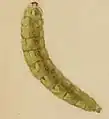Ectoedemia argyropeza
Ectoedemia argyropeza is a moth of the family Nepticulidae. It is a widespread species, with a Holarctic distribution.
| Ectoedemia argyropeza | |
|---|---|
.jpg.webp) | |
| Scientific classification | |
| Domain: | Eukaryota |
| Kingdom: | Animalia |
| Phylum: | Arthropoda |
| Class: | Insecta |
| Order: | Lepidoptera |
| Family: | Nepticulidae |
| Genus: | Ectoedemia |
| Species: | E. argyropeza |
| Binomial name | |
| Ectoedemia argyropeza (Zeller, 1839) | |
| Synonyms | |
|
List
| |
Description
The wingspan is 7 mm. The head is ochreous-yellow with a whitish collar. The antennal eyecaps are also whitish. Forewings dark fuscous ; a small costal spot before middle, and a larger dorsal spot before the tornus whitish ; outer half of cilia whitish. Hindwings grey.[1]
Adults are on wing from May to June.[2] It is a parthenogenetic species, with males being extremely rare.
The larvae feed on aspen (Populus tremula) and quaking aspen (Populus tremuloides (ssp. downesi)). They mine the leaves of their host plant. It first bores in the petiole, resulting in a swelling. When the larva reaches the leaf disc, it makes an elongate blotch between the midrib and the first lateral vein. The frass is concentrated in two stripes parallel to the sides of the mine. Pupation takes place in the soil.[3]
Subspecies
- Ectoedemia argyropeza argyropeza
- Ectoedemia argyropeza downesi Wilkinson and Scoble, 1979 (North America)
Distribution
It is found in most of Europe, as well as North America. In Russia, it is found in St. Petersburg, Moscow, Kaluga, Tatarstan and Kaliningrad.[4] It is also known from north-eastern China.
Gallery

 Larva
Larva
References
- Mayrick, E (1895). A Handbook of British Lepidoptera. London: MacMillan.
 This article incorporates text from this source, which is in the public domain. Keys and description
This article incorporates text from this source, which is in the public domain. Keys and description - Kimber, Ian. "4.085 BF23 Ectoedemia argyropeza (Zeller, 1839)". UKmoths. Retrieved 30 March 2023.
- Ellis, W N. "Ectoedemia argyropeza (Zeller, 1839) virgin pigmy". Plant Parasites of Europe. Retrieved 30 March 2023.
- Nepticulidae from the Volga and Ural region